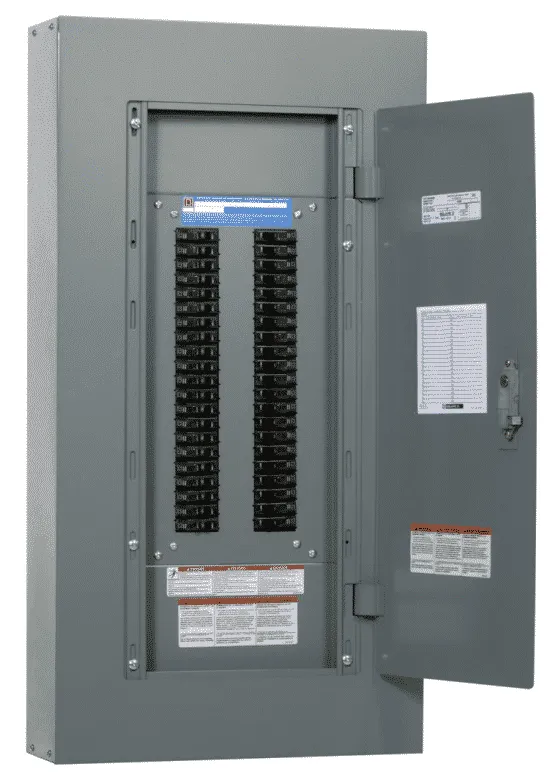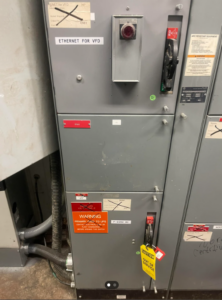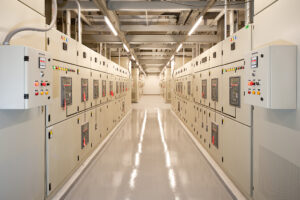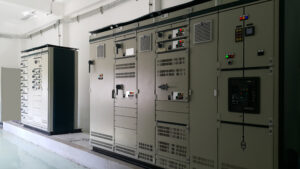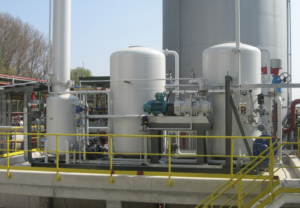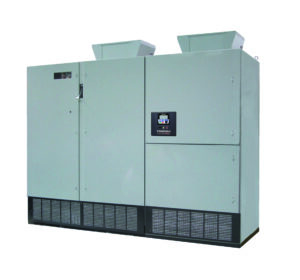Deploying a panelboard vs load center is an occasional debate in electrical distribution centers. Although these equipment serve the same purpose, distributing power from the mains to smaller circuits, their application varies. Load centers are ideal for applications involving smaller current and voltage ratings. Meanwhile, panelboards can handle and serve larger systems where the current and voltage ratings are higher. In this article, we delve into the features of a panelboard vs a load center, as well as compare various aspects of their application.
What is a Panelboard?
Panelboard refers to an assembly within an enclosure consisting of busbars, overcurrent devices, switches, etc., enabling power distribution to multiple circuits. They are ideal for safe and efficient power distribution to different facility sections. These could be residential, commercial, or small industrial facilities, but they need to be operating between 120 and 600 V. Basic components that make up a panelboard are as follows;
- Main Breaker: This is the board’s primary switch, isolating power from all the branch circuits.
- Busbars are metal strips of aluminum or copper connected to the main breaker. Moreover, they carry the current from the main brakes to the branch circuits.
- Circuit Breakers: Each circuit has a breaker connecting its busbar and corresponding load. They protect the circuits from overload and short circuits.
- Neutral & Ground Busbars: The neutral wiring provides a return path for current to the power source. The setup also includes ground busbars for safety.
One key component is using insulation to prevent arcing, which poses a danger to the equipment and operators. Different dielectric materials can serve this purpose, the most common being air, oil, and gas like SF6. Air is suitable for lower current and voltage ratings, while gas and oil help maintain safety at higher voltage levels.
What is a Load Center?
A load center (or fuse box) is a small electrical panel that distributes electricity in small facilities like residential buildings. Like a panelboard, a load center also contains circuit breakers for each branch connection, protecting the circuit in case of overload or short circuits. However, the components of a load center have much smaller voltage and current ratings than a panelboard. In a typical US residence, a load center distributes electricity to loads rated at 110 to 120 V.
Comparison Between a Panelboard vs a Load Center
A panelboard and load center share similarities in appearance, as their enclosures provide access for maintenance only from the front. However, there are several differences, which the following sections highlight.
Enclosure Material and Size of Panelboard vs Load Center
Panelboard enclosures are made with high-grade materials like stainless steel or aluminum for durability and to withstand large electrical pressure. Additionally, the sizes of panelboards are relatively much larger than load centers. On the other hand, load centers are smaller in size. Their enclosures usually constitute cold rolled steel for indoor use and galvanized steel for outdoor setups. These materials are more cost-effective, offering good strength and wear resistance.
Voltage & Current Capacity of Panelboard vs Load Center
The load centers serve in applications ranging between 110 to 240 V (sometimes up to 400 V). As for its current ratings, they are usually less than 400 amps. Meanwhile, panelboards are ideal for systems operating between 120 and 600 V. With a current capacity of up to 1,200 amps.
Circuit Breakers
Although the NEC has relaxed its limitation of 42 circuits per panel, it is common to find this practice in load centers. A typical load center accommodates only plug-in breakers vs a panelboard, which can house both plug-in and bolt-on breakers. In combination with its greater depth, panelboards can accommodate more circuits than load centers.
Applications
The panelboard suits high current loads and complex electrical distribution applications, such as manufacturing setups, commercial buildings, and data centers. In contrast, load centers are used in small residential and commercial setups.
Furthermore, the load centers are simple and come with all the components connected already inside the enclosure. In contrast, the panel boards might require setting up individual components during the installation.
Standard Compliance & Customization
The panelboards and load centers have different standards for panel safety, reliability, and performance. Common panelboard standards include UL 67 and NEMA PB1. Meanwhile, the standard codes for load centers are NEC, UL 67, etc.
Also, panelboards are highly compatible with customization options, including custom circuit breakers, modular design, current load rating, and circuit numbering. Other optional features may include main and branch circuit energy monitoring, surge suppression devices, and a three-phase bus. In contrast, load centers focus primarily on standard residential and light commercial applications, thus having fewer customization features.
Cost
The advanced control and protection features, higher voltage and current capacity, and extensive customization options make industrial panelboards more expensive than load centers. Additionally, advanced panelboards involve a monitoring system and require frequent maintenance, increasing the overall cost.

